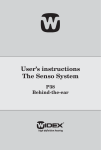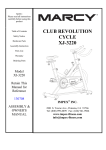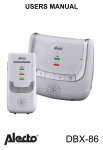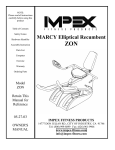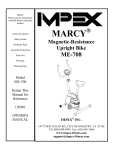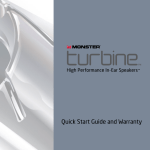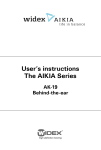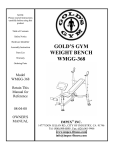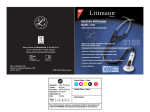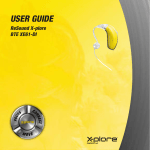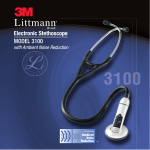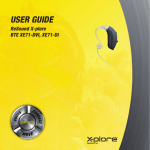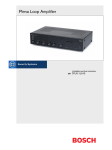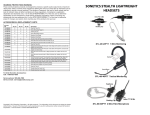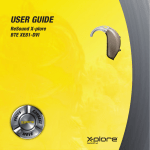Download SmartAid and SmartAid Digital BTE User Manual
Transcript
Clear Hearing Delivered To Your Door From Hearing Care Experts User Guide SmartAid and SmartAid Digital BTE Hearing Aids www.clearlyhearing.com Thank You for choosing Clearly Hearing on your journey to a life of Better Hearing! We have put great care and attention into making sure that your hearing aids are of the highest quality and that they are easy to use and maintain. Please familiarize yourself with the information in this booklet, where you will find instructions for inserting and removing your hearing aids, and explanations on controlling your hearing device for daily use. Proper understanding and use of your hearing aids will allow you to derive maximum hearing benefit. 2 Content The Parts of Your Hearing Aids……....….…4-5 General Introduction………..………....……6 Operating Principles……………..……….....7 Technical Specifications……………..……...7 Changing Battery……….…………..........….8-9 Turning your Hearing Aids ON/OFF………..10 Attaching EarTube and EarBud.......................11-12 Placing the Hearing Aids On the Ear…....…..12 Removing the Hearing Aids………..……..…...12 Memory Button………………………………..14 Volume Control……….. ………………….…..15 Fine tuning (for manually controlled digital BTE.......16 Telephone Use…………….……….…………..18 Hearing Aids Care In Case of Malfunction…...………….………..19 Daily Cleaning………….……………………. 20 Troubleshooting Guide………………………..24 Enjoy with ‘Plan’……….……………………..25 3 The Parts of your SmartAid Analog BTE a) Earhook b) Volume Control c) Battery Door d) Shell e) Trimmer f) Switch (Not Available) g) Programming Cover Back Printing: h) Logo i) Model No. j) Series No. 4 The Parts of your SmartAid Digital BTE Digital BTE a) Memory Button b) Shell c) Microphone d) Volume Control e) Earhook f) Battery Door 5 General Introduction Usage Hearing Aids are sound-amplifying devices intended to compensate for the hearing impaired. Operating Condition: Temperature:0—40℃, 80﹪, Humidity:0— Voltage:1.2—1.4V. Impact on the Environment Return them to your hearing aids specialist for proper, environmentally conscious disposal. Safety Do not throw the dead batteries into fire to cause any explosion! Keep batteries away from children! Batteries must not be swallowed. People with pacemakers had better not use the hearing aids. 6 Operating Principles Hearing aids pick up signals through the microphones and then convent them to either digital or electrical signals depending on the type of the hearing aids; then the signals picked up by the hearing aids are amplified. When the signals are amplified, the sounds that are then passed on to users are also amplified. The amount of amplification varies for different hearing loss among users and can be preset by the audiologist or controlled through various knobs by users. Technical Specification In reference to ANSI S3.22-1996 or IEC118-7 Standard 2CC Coupler. 7 Changing Battery Before inserting new batteries into your hearing aids, remember to remove the adhesive tab. Do not use battery on which there is a sticky residue from the tab or other unwanted substance as this can block the battery air holes. Push the nail grip downwards to swing open the battery drawer. The nail grip is located on the opposite side of the on/off switch at the bottom of the hearing aids. The battery must be placed with the plus (+) sign in accordance with the plus(+)sign on the battery drawer. If the battery door does not close easily, the battery is incorrectly inserted. 8 When inserting batteries, make sure to hold the hearing aids over a table or a carpet to make it easier to find a dropped hearing aids or battery. Exhausted batteries: If you hear two rapid beeptones while wearing your hearing aids, it is an indication that you should exchange the battery as soon as possible. Once the battery is totally exhausted, the hearing aids will be completely silent. Exactly how long the hearing aids will function after the beep-tones varies from one case to another. We recommend that you always have a spare battery with you. 9 Never leave an exhausted battery in the hearing aids. Exhausted batteries may leak, which could damage your hearing aids. 1. Turning your Hearing Aids ON/OFF Your hearing aids are equipped with an on/off switch that is integrated into the battery compartment, which functions: ON, When the battery door is fully closed. OFF, When the battery door is open. To turn hearing aids off, grasp the battery compartment door with a fingernail and gently pull downwards. Please remember to switch the hearing aids off when it is not in use to reduce battery consumption. 10 Attaching EarTube First cut an EarTube to the right size. The EarTube needs to be pushed over the ear hook of the hearing aid so that it attaches securely. 11 Select an EarBud that fits your ear canal comfortably, if your hearing aid whistles select a larger earbud or reduce the volume. You can also order a custom EarMold from a local hearing clinic and attach it to your new hearing aid. This may provide a more comfortable fit and eliminate any feedback problems. 1. Insert a Battery Insert a battery in your hearing aids, and turn the volume down or turn off the hearing aids before placing it on the ear. 12 Placing the Hearing Aids On the Ear Place the hearing aid behind your ear, then insert the ear mold in the ear canal while holding the lower part of the tubing. It may also be helpful to gently pull the outer ear backwards and upwards with the opposite hand. 2. When the hearing aid is in its correct position, increase the volume to a comfortable level. Removing the Hearing Aids First remove the hearing aids from the position behind the ear. 3. Carefully pull the ear mold out of the ear canal while holding the lower part of the tubing. If it is difficult, it may help to try to move the ear mold carefully from side to side while pulling it out. It may also help to pull the outer ear upwards and backwards with the opposite hand. 13 6. Memory Button (SmartAid Digital BTE only) Your hearing aids come preset with three unique programs. Program 1: Meant for hearing in quiet places. Program 2: Meant for hearing in noisy places. Program 3: Telecoil Mode; meant for hearing on telephone and in public places that are wired to work through a hearing aids telecoil. You can change between programs by lightly pressing the memory button. You will hear one beep, 2 beeps or 3 beeps to tell you which program you are on. Each time the battery door is opened and closed the hearing aid restarts on Program 1. 14 7. Volume Control SmartAid: Rotate the volume control knob upwards to raise the volume, and downwards to lower the volume. The knob indication value is from 1, indicating minimum volume, to 4, indicating maximum volume. Note: Please avoid prolonged use at uncomfortably loud environment—it might damage your hearing. For further information, consult your hearing healthcare professionals. 15 SmartAid Digital BTE Press the top button to turn the hearing aid louder and turn the bottom button to turn the hearing aid quieter. Each time the battery door is opened and closed the hearing aid restarts on at the middle volume position. 16 8. Fine tuning ( for SmartAid BTE) SmartAid has a screwdriver control hidden under a small panel on the back of the hearing aid. You can adjust the pitch and volume of the hearing aid by rotating this knob. LC (Low-frequency Control): Spin with a screwdriver CLOCKWISE to lower LC, and counter CLOCKWISE to increase LC. 17 9. Telephone Use The telecoil mode is intended for telephone use. In the telecoil mode, place the telephone receiver close to your hearing aids for best reception. By trying various positions with the telephone receiver, you will discover what works best for you. After phone call, do not forget to switch to the microphone mode for normal speech listening. Telecoil Mode is Program 3 and is only available on SmartAid Digital BTE. 18 In Case of Malfunction Should your hearing aids be completely or periodically dead, try the following before consulting your hearing healthcare professional: Make sure the hearing aids are switched on. Disconnect the tubing with the earmould from the hook of the hearing aids and check if there is moisture in the tubing. Check that the earmould is not blocked by earwax. Disconnect the tubing with earmould from the hook of the hearing aids and try to blow air through the earmould with a small blower. Change the battery and make sure the new battery is correctly inserted. 19 Daily Cleaning 1.The Earmould Earwax accumulates on your earmould. This can lead to inflammation in your auditory canal if the aids are not cleaned regularly. Make sure your earmould is clean and free of earwax. If it is plugged, clear the opening with the removing tool (screwdriver, brush, etc.). If this is not sufficient, disconnect the plastic tube from the hook of the hearing aids and wash the earmould in warm soapy water. Rinse in cold water. Allow the earmould to dry overnight. If there is still moisture in the earmould or tube, use a syringe or a small blower to blow it dry. Do not use solvents, cleaning fluids or oil to clean your earmould! If your earmould tubing becomes stiff, yellow or cracked, contact your hearing healthcare professional for a replacement. 20 2. The Hearing Aids Never wash your hearing aid with water, cleaning solutions or other liquids. Instead, clean your hearing aids with a dry soft cloth after use. Try to perform all cleaning above a soft cloth or towel on a desk or table to keep the aids from potentially damaging falls to hard surfaces if you drop it. When the hearing aids are not in use, it is a good idea to leave the battery drawer open, so as to ventilate the aids and allow them to dry. 21 Helpful Hints 1. Periodic Inspection Bring your hearing aids regularly to your hearing aids specialist, on the schedule that he or she recommends to have the accessories changed or the device checked. 2. Moisture-proof Place it in a “Dri-Aids kit” to draw damaging moisture out of the aids overnight. Hearing aids and their accessories should not be disposed of with normal household waste. Please consult your national distributors for advice on how to dispose of these items. 3 . Anti-high Temperature Never expose it to extreme temperatures. 4 Anti-vibration . Do not drop your hearing aids or knock them against hard 22 surfaces. 5. Others Do not wear your hearing aids during x-ray, MR scans, CT scans, short-wave diathermy, or similar radiation treatments. Please use special battery for hearing aids. Switch your hearing aids off when they are not in use. Should you not use them for a day or more, take out the battery to avoid battery leakage. 6. Storage Keep it in dry, clean, cool condition. 23 Troubleshooting Guide If there is any other problem not mentioned in this guide, or should questions arise, please contact us for support. 24 Enjoy with ‘Plan’ Hearing aids reproduce an abundance of sounds which frequently haven’t been experienced for many years. Every person reacts differently the first time he or she wears hearing aids. The familiarization phase therefore differs from person to person. Below is a rehabilitation plan for first time users or those using new hearing aids. The First Week 1 to 2 hours wearing per day, you are suggested to wear in a relatively quiet environment to familiarize and distinguish various sounds. The Second Week 4 to 8 hours wearing per day, you may wear your hearing aids and walk in a relatively quiet environment to listen around. The Third Week You may wear hearing aids and go to public areas. You may have dialogue with your friends or even strangers. 25 Enjoy with ‘Plan’ The Fourth Week You may prepare for travelling to another city, go to supermarket, restaurant, participate in music concert or watch video. You can do whatever you like! Then you may find many enjoyments in life with clear hearing again. In a few weeks, you will probably be able to use your aids all day without fatigue or tension, and you are likely to “forgetting” that you are even wearing hearing aids. 26 Thank you for choosing Clearly Hearing on your journey to a life of better Hearing. Refer to our website for: Troubleshooting I FAQ’s I Repairs Warranty I Re-Programming I Exchange & Refund Policies I Purchasing Hearing Aid Batteries, Replacement Ear Tubes and Ear Buds. www.clearlyhearing.com 1-855-263-4327 life of BETTER hearing.





























